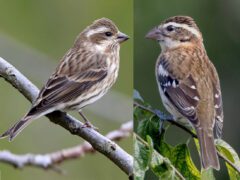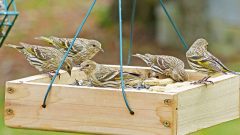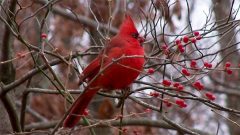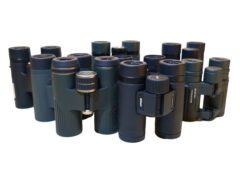Purple Finch Photo Gallery
Adult male (Eastern)
Small finch with a conical seed-eating bill. Adult males have a raspberry red head, breast, and back.
© Henry Trombley / Macaulay LibraryVermont, April 13, 2018Female/immature (Eastern)
Females are coarsely streaked below, with strong facial markings including a whitish eyebrow and a dark line down the side of the throat.
© terence zahner / Macaulay LibraryNew York, December 09, 2018Adult male
Often forages in the upper parts of trees eating mainly seeds and soft buds of evergreen trees and elms, tulip poplars, maples, and others.
© Eric Liner / Macaulay LibraryNew York, May 01, 2009Not all videos have soundAdult male (Western)
"Western" Purple Finches occur along the Pacific Coast from British Columbia to Baja California. Compared to "Eastern" males, "Western" males have more olive-green coloration and generally have brown markings on the sides and flanks.
© Sergey Pavlov / Macaulay LibraryCalifornia, January 19, 2020Female/immature (Western)
Individuals from the western states tend to be more olive colored on the back with less well-defined streaks on the belly. Their head pattern is also less distinct.
© Jeff Bleam / Macaulay LibraryNevada, February 01, 2017Adult male (Eastern)
Small, somewhat stocky finch. Like other finches, it has a notched tail. Adult males have a raspberry red head, breast, and back.
© Jeff Maw / Macaulay LibraryNorth Carolina, November 14, 2018Female/immature (Eastern)
Females/immatures are brown overall with crisp brown streaking on the breast and flanks. Also note white eyebrow.
© James Rieman / Macaulay LibraryTexas, December 27, 2020Adult male (Eastern)
Purple Finches are erratic migrants that follow cone crops. Typically they leave Canadian breeding grounds to winter widely across the central and southeastern U.S, returning to specific regions roughly every other year.
© Lucas Bobay / Macaulay LibraryNorth Carolina, December 25, 2020Habitat
In winter, found in a wider variety of habitats, including shrublands, old fields, forest edges, and backyards.
© Evan Lipton / Macaulay LibraryRhode Island, February 02, 2017Habitat
Breeds mainly in evergreen forests or mixed woodlands.
© Anita Morales / Macaulay LibraryQuebec, July 16, 2017Compare with Similar Species
Click on an image to compare
Species in This Family
Finches, Euphonias, and Allies(Order: Passeriformes, Family: Fringillidae)
More to Read
Don't miss a thing! Join our email list
The Cornell Lab will send you updates about birds,
birding, and opportunities to help bird conservation.
























